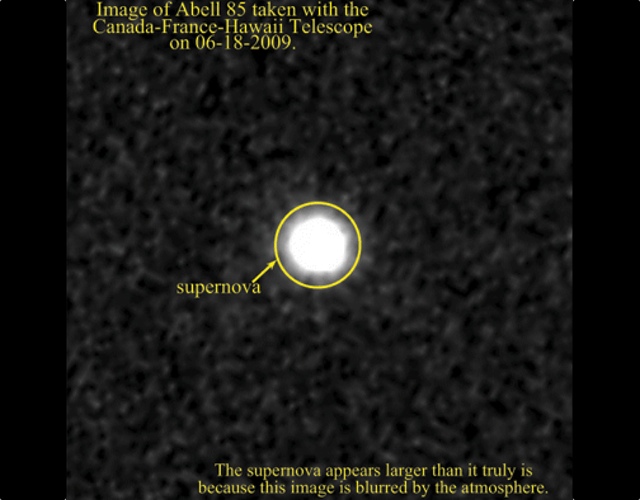Concept drawing of a Type Ia supernova exploding in the region between galaxies. Image: Dr. Alex H Parker, NASA and the SDSS
From our perspective on Earth, the night skies are liberally sprinkled with planets, stars, and even the dusty contours of the Milky Way. But by some estimates, up to half the stars in the universe have been denied this spectacular view, having been catapulted into the dark expanse of intergalactic space by the gravitational whims of their host galaxies.These orphaned stars are usually too dim to detect during their lifetimes, but their explosive deaths are another story. To that end, a team led by Berkeley astrophysicist Melissa Graham just announced the discovery of three lonely stars that went supernova far from their parent galaxies. The team's results are available on arxiv.org, and are also slated for publication in the Astrophysical Journal."We have provided the best evidence yet that intracluster stars truly do explode as Type Ia supernovae, and confirmed that hostless supernovae can be used to trace the population of intracluster stars, which is important for extending this technique to more distant clusters," Graham said in a statement. The three supernovae are located about a billion light years away, in a region characterized by dense clusters of galaxies. They were flung into the intracluster void millions—perhaps even billions—of years ago, and as a result, they are about 100 times more isolated from other stars than the Sun is from its neighbors.All of these stars ended their lives as Type Ia supernovae, meaning that they were the swan songs of long-lived white dwarfs that had spent eons wandering through the intracluster medium."This is as expected," Graham told me over email. "[T]he population of intracluster stars should be predominantly old, because they are stars that were tidally stripped from their host galaxies by the gravitational forces of the cluster potential, and traveled for a long time to get so far away from their original galaxy."Animation of a Type Ia supernova. Credit: NASA/YouTube."Supernovae of Type Ia are exploding white dwarfs, which are older and more evolved, and are the only kind of supernovae, that we know of so far, that very old stars can become," she continued. "Supernovae of Type II and Type Ib/c […] are exploding young stars, so if we found one so far from any galaxy, it would be quite a surprise!"It's mind-boggling to imagine these ancient stars meeting their luminous end so far from their parent galaxies. As an avid science fiction fan, Graham noted that the whole scenario is reminiscent of Iain Banks 1993 novel Against a Dark Background, which takes place on an inhabited planet orbiting an orphaned star.Galactic exile seems as if it would be intrinsically hostile to life, but as Graham speculates, it may actually be an advantage in the long run. "I am not an expert in this area, but I think that if there were planets in a solar system around a binary star that is tidally stripped from its host galaxy by the cluster's gravitational potential, it could all remain intact during this process," she told me."The tidal stripping process is actually relatively gentle—more like a slow drift away than a big sudden pull," she explained. "For any hypothetical inhabitants of such a solar system, I expect they could survive the intracluster void, and that the potential habitability would not necessarily be affected.""If anything, I think it might improve their chances, as they are now statistically less likely to experience an event that does affect habitability, such as a nearby supernova or a close stellar passage," Graham added. Of course, whatever life may have been nurtured by these exiled stars would have been blown into oblivion by their inevitable detonations.But regardless of whether these star systems were inhabited, their radiant deaths have the potential to shed light on the murky world of intergalactic space. Along those lines, Graham plans to continue searching for these brilliant supernovae to help contextualize larger questions about the universe's darkest regions."I would love to pursue the question of how the fraction of intracluster stars changes over cosmic time, as rich clusters of galaxies are assembled in the Universe," she said, noting that there have already been attempts to do such surveys using the Canada-France-Hawaii Telescope.
The three supernovae are located about a billion light years away, in a region characterized by dense clusters of galaxies. They were flung into the intracluster void millions—perhaps even billions—of years ago, and as a result, they are about 100 times more isolated from other stars than the Sun is from its neighbors.All of these stars ended their lives as Type Ia supernovae, meaning that they were the swan songs of long-lived white dwarfs that had spent eons wandering through the intracluster medium."This is as expected," Graham told me over email. "[T]he population of intracluster stars should be predominantly old, because they are stars that were tidally stripped from their host galaxies by the gravitational forces of the cluster potential, and traveled for a long time to get so far away from their original galaxy."Animation of a Type Ia supernova. Credit: NASA/YouTube."Supernovae of Type Ia are exploding white dwarfs, which are older and more evolved, and are the only kind of supernovae, that we know of so far, that very old stars can become," she continued. "Supernovae of Type II and Type Ib/c […] are exploding young stars, so if we found one so far from any galaxy, it would be quite a surprise!"It's mind-boggling to imagine these ancient stars meeting their luminous end so far from their parent galaxies. As an avid science fiction fan, Graham noted that the whole scenario is reminiscent of Iain Banks 1993 novel Against a Dark Background, which takes place on an inhabited planet orbiting an orphaned star.Galactic exile seems as if it would be intrinsically hostile to life, but as Graham speculates, it may actually be an advantage in the long run. "I am not an expert in this area, but I think that if there were planets in a solar system around a binary star that is tidally stripped from its host galaxy by the cluster's gravitational potential, it could all remain intact during this process," she told me."The tidal stripping process is actually relatively gentle—more like a slow drift away than a big sudden pull," she explained. "For any hypothetical inhabitants of such a solar system, I expect they could survive the intracluster void, and that the potential habitability would not necessarily be affected.""If anything, I think it might improve their chances, as they are now statistically less likely to experience an event that does affect habitability, such as a nearby supernova or a close stellar passage," Graham added. Of course, whatever life may have been nurtured by these exiled stars would have been blown into oblivion by their inevitable detonations.But regardless of whether these star systems were inhabited, their radiant deaths have the potential to shed light on the murky world of intergalactic space. Along those lines, Graham plans to continue searching for these brilliant supernovae to help contextualize larger questions about the universe's darkest regions."I would love to pursue the question of how the fraction of intracluster stars changes over cosmic time, as rich clusters of galaxies are assembled in the Universe," she said, noting that there have already been attempts to do such surveys using the Canada-France-Hawaii Telescope. "In the future, when the Large Synoptic Survey Telescope begins regular monitoring of the sky to very faint magnitudes, I think that enough cluster and intracluster supernovae will be found to pick up this project again," she concluded.For most of astronomical history, researchers have naturally focused on studying the behavior of luminous megastructures, like galaxies. But as Graham's team has shown, the shadowy abysses between these radiant entities can be just as fascinating, and we have only just begun to explore their depths.
"In the future, when the Large Synoptic Survey Telescope begins regular monitoring of the sky to very faint magnitudes, I think that enough cluster and intracluster supernovae will be found to pick up this project again," she concluded.For most of astronomical history, researchers have naturally focused on studying the behavior of luminous megastructures, like galaxies. But as Graham's team has shown, the shadowy abysses between these radiant entities can be just as fascinating, and we have only just begun to explore their depths.
Advertisement
Advertisement
